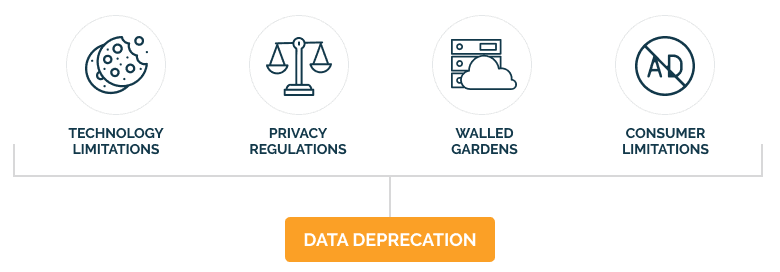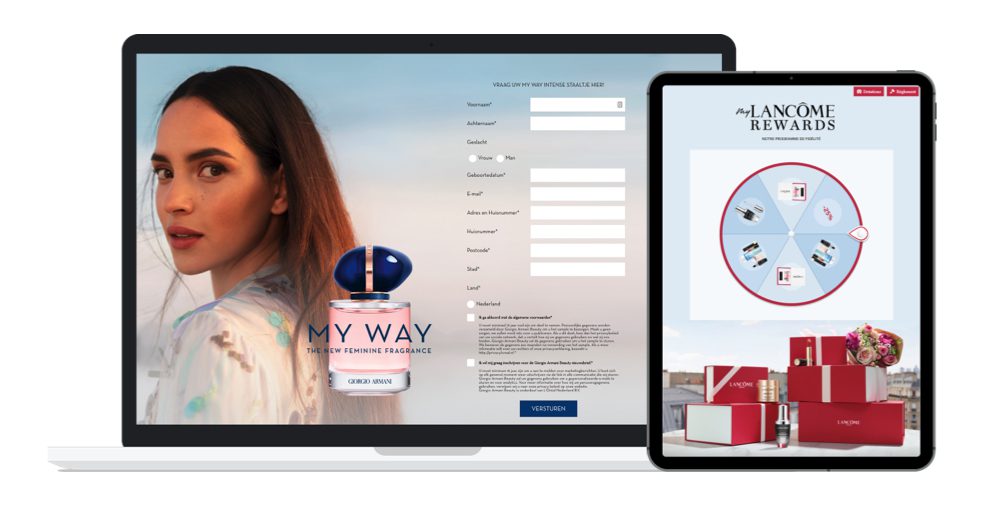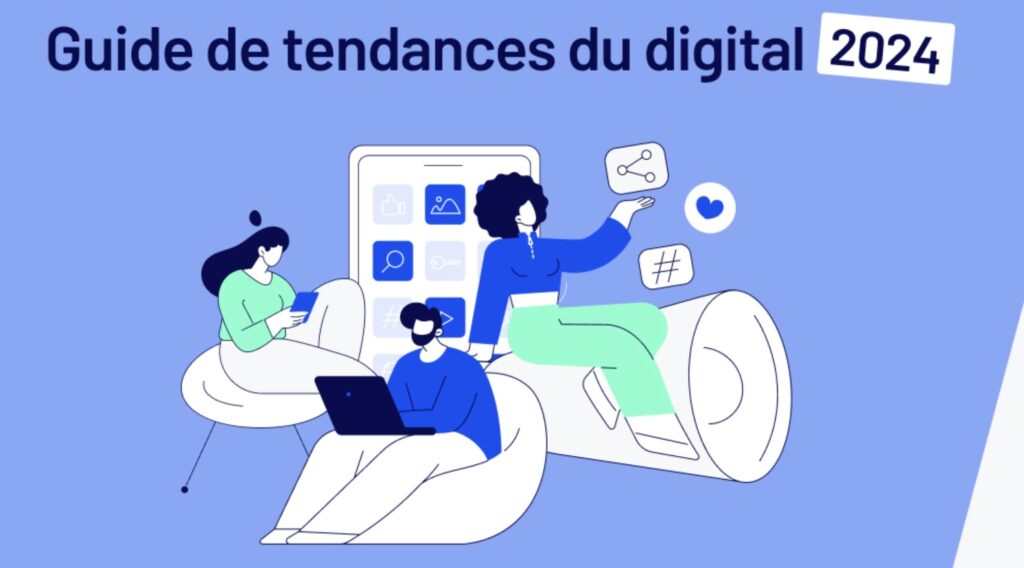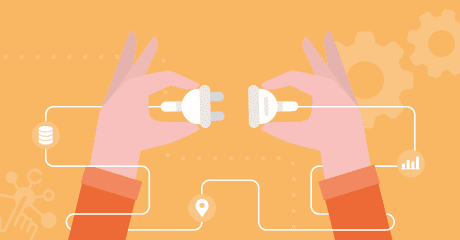2024 data trends: navigating the era of data deprecation
As we have now stepped into this new year, the importance of efficient and impactful data collection has never been more crucial. Many changes will happen this year in the digital world, and these changes made us wonder what the biggest 2024 data trends would be.
As you may already know, a significant change in 2024 in the data world will definitely be the restrictions that Google will impose on third-party cookies. In other words, third-party cookies won’t be allowed anymore. This will force businesses to redefine how they access and use data, focusing on transparency and consent.
Four important data trends will be marking the year 2024 regarding data collection and following these third-party cookie restrictions. Considering these trends will be crucial for businesses that want to continue to harness the power of data, and for those that will come out of 2024 leading in the cookieless world.
Data deprecation: it’s real!
For many years, businesses have had unlimited access to consumer data without restrictions. These data were used and sold to third parties without any kind of consideration for consumers. The growing awareness of consumers about the value of their personal data generated many debates, forcing governments to regulate access to data. In the European Union, this led to the implementation of the GDPR, protecting the data of European citizens globally and any data collected within the Union. The GDPR forces data collectors to be transparent about the reasons for collecting data from individuals and the time the data will be stored.

Until now, organisations could acquire third-party data to gather information about individuals, useful for practices such as targeted advertising. However, with the expiration of third-party cookies, access to such data is about to disappear. But what are we going to do with this huge amount of data? What will be its value? Regulations like the GDPR are pushing data collection practices towards obtaining first- and zero-party data with the explicit consent of the individuals sharing it. This shift will progressively make third-party data lose its value, making it completely useless.
This process is called data deprecation. As you might already know, data deprecation refers to the deliberate and systematic discontinuation of the use, storage, or availability of certain data. This discontinuation can occur for various reasons, such as data becoming outdated, irrelevant, or even privacy-sensitive. It involves removing or limiting access to deprecated data, often in compliance with privacy regulations. This proactive approach helps organisations ensure that only current, accurate, and necessary data is retained. It also minimises the risks associated with retaining unnecessary or sensitive information.
Data deprecation is now leading businesses to reconsider the way they collect data and engage with audiences.
The four 2024 data trends
The data universe is quite vast and, let’s admit it, pretty complex. Data experts are continuously looking for emerging trends, especially since data collection can serve a thousand different purposes. However, based on our expertise, we’ve extracted the four 2024 data trends that will shape data collection. Not only have we analysed them, but we’ve also made sure they will provide value and knowledge for organisations willing to collect data in an efficient way.
Enough talking; let’s dive right in and check what these trends will be about.
1. First in line: reevaluate your data collection strategy
Reevaluating your data collection strategy will be a crucial trend in 2024, especially when considering data deprecation. And this will be the case for many different reasons. Among these reasons, you’ll find:
- Adapting to regulations: with data deprecation, organisations need to adjust their strategies to fully comply with GDPR. They need to ensure that their data collection practices align with the latest legal requirements.
- Minimising risks: reevaluating their strategy will allow organisations to identify and minimise privacy risks associated with the data they collect, promoting a responsible and ethical approach.
- Improving data quality: by reassessing data collection methods, businesses can enhance the quality of their data. This contributes to more reliable analytics, decision-making, and customer interactions.
- Nurturing trust with your audience: your audience is aware and concerned about data privacy. By reevaluating and adapting your data collection strategy, you demonstrate a commitment to responsible data management. This fosters trust with your audience, as they see you taking steps to prioritise their privacy.
2. First- and zero-party data on the rise
Collecting first- and zero-party data will be crucial and one of the major 2024 data trends to comply with all new regulations imposed by GDPR to protect the consumer. Why? Because these kinds of data are collected transparently, with the consent of individuals.
The difference between first- and zero-party data lies in the way users give their consent. First-party data consists of mandatory information that users provide to purchase or access a service (name, gender, date of birth, address). On the other hand, zero-party data is optional information (pets, children, tastes, preferences, etc.) that the users choose to voluntarily provide to a company to enhance their experience and the service they provide.
The transition from third-party data to a strategy focused on first- and zero-party data collection will enable brands and businesses to get reliable and actionable data that enriches their database and facilitates the personalisation of communications with their audiences. The goal is to achieve every marketer’s dream: delivering “the right message, at the right time, on the right channel.”

Remember L’Oréal’s success story? They successfully used the Qualifio platform in 2023, launching a European data collection program to collect first- and zero-party data. Their goal by using Qualifio was to increase the number of contacts in their database, as well as the quality of the information about these contacts through zero-party data collection. The result? In a little over a year, L’Oréal EMEA created 700 Qualifio campaigns and reached more than 5.5 million registered users, with a percentage of accounts created between 60 and 70% of the participants of each campaign. What else do you need?

With Qualifio, we can address two objectives: firstly, to increase the number of contacts we have in our database and, secondly, to work on improving the quality of these contacts. When we launched the data capture program, we were at 0 contacts in our CRM. Today, in Italy, where we started the first pilot program, more than 50% of the contacts come from Qualifio.
3. Less is more!
Yes, you’ve read it well. Businesses will have to stop collecting more data than they need. That’s why the principle of minimisation will be one of the most essential 2024 data trends, promoting quality over quantity. You might not have thought about it, but data takes space and energy.
Companies will have to minimise the collection of data that would be unnecessary as much as possible. In other words, strictly applying the principle of minimisation, a concept of the GDPR, which dictates that “personal data must be adequate, relevant, and limited to what is necessary in relation to the purposes for which they are processed.”
Personal data must be adequate, relevant, and limited to what is necessary in relation to the purposes for which they are processed.
Beyond ensuring GDPR compliance, the application of this principle offers other benefits, such as reducing storage costs, simplifying processing by retaining only essential and actionable data, and establishing a healthy and lasting relationship with the consumer built on trust.
4. Interactive marketing & gamification for the win
It’s quite clear by now that in 2024, you’ll have to innovate. Interactive marketing and gamification can be what gives you an edge compared to other organisations. This involves implementing marketing campaigns using gamified formats, in which individuals participate and share their data in exchange for an interactive experience, a concept known as value exchange. Organisations can offer many interactive and engaging formats to their audiences, including puzzles, quizzes and personality tests.
Besides strengthening brand awareness, fostering engagement, and building audience loyalty, interactive marketing and gamification facilitate the collection of first- and zero-party data, providing consumers with useful, valuable and entertaining content. In the long run, collecting data actively contributes to boosting sales growth and generating revenue for brands.
Still not convinced? This was actually the strategy the France 2023 organisation adopted during the Rugby World Cup. The different departments of the organising committee used several of our interactive formats to engage their community with entertaining content, such as quizzes or contests. The results were outstanding. During the Six Nations Tournament, 14 chrono quizzes were created, resulting in nearly 340,000 participations. France 2023 successfully expanded its database while engaging the rugby community in the build-up to the World Cup.

What’s next?
In 2024, brands and businesses will be obligated to adopt a fully transparent approach to data collection. The collected data should, among other things, be consented, compliant, and actionable, enabling a respectful approach towards the consumer. In a cookieless world, this will inevitably involve a transition towards the collection of first- and zero-party data through interactive marketing.
A full ebook on the 2024 digital trends
We recently had the opportunity to publish an article about the 2024 data trends in the latest BDM ebook (Blog Du Modérateur). This yearly ebook is an amazing resource for anyone interested in the digital trends that will shape 2024.
Many renowned companies, including PlayPlay, Prestashop, Partoo and Kameleoon, have also contributed to this ebook. They’re all sharing their knowledge about the trends in terms of social media, video engagement, influencer marketing, retail strategy, personalisation, HR, and more!
Make sure you download your version of the ebook on the biggest digital trends of 2024!









